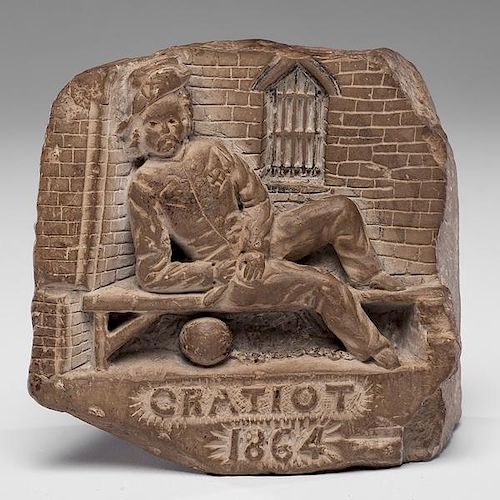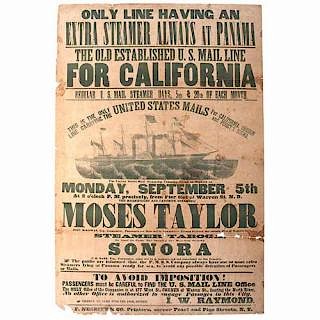Confederate POW Cotton Stone Carving from Gratiot Prison, St. Louis, Missouri, Possibly Identified
About Seller
6270 Este Ave.
Cincinnati , OH 45232
United States
With offices in Cincinnati, Cleveland and Denver, Cowan’s holds over 40 auctions each year, with annual sales exceeding $16M. We reach buyers around the globe, and take pride in our reputation for integrity, customer service and great results. A full-service house, Cowan’s Auctions specializes in Am...Read more
Two ways to bid:
- Leave a max absentee bid and the platform will bid on your behalf up to your maximum bid during the live auction.
- Bid live during the auction and your bids will be submitted real-time to the auctioneer.
Bid Increments
| Price | Bid Increment |
|---|---|
| $0 | $25 |
| $500 | $50 |
| $1,000 | $100 |
| $2,000 | $250 |
| $5,000 | $500 |
| $10,000 | $1,000 |
| $20,000 | $2,500 |
| $50,000 | $5,000 |
| $100,000 | $10,000 |
About Auction
Jun 10, 2016 - Jun 11, 2016
Cowan's Auctions dawnie@cowans.com
- Lot Description
Confederate POW Cotton Stone Carving from Gratiot Prison, St. Louis, Missouri, Possibly Identified
Cotton stone statue of a Confederate Prisoner of War inscribed on the bottom, CSA Capt. G.W. Carter. Carved on the bottom of the face reads, Gratiot 1864, which refers to Gratiot Street Prison in St. Louis, MO. Believed to be made in the likeness of Captain Carter or one of his cell mates, the suave officer reclines on his prison bench with a ball and chain shackled to his ankle. He wears a Cavalry short jacket and a Hardee hat with the front brim turned up. Behind him is an arched barred prison window and meticulously carved bricks. On top of the carving is a small hole surrounded by a star, possibly meant to hold a writing utensil. 4 x 4 in.
Carving was an important part of survival at Alton and Gratiot and resulted in the development of many skilled carvers within the prisons. Confederate soldiers Q.A. Pearson and William H. Willis were held at Alton prison (Illinois) in the spring of 1862. Each carved stone pipes with the same material as the statue with equally impressive designs. Even though Pearson and Willis left Alton in 1862, the carving culture continued until 1865. Carter transferred from Gratiot to Alton in July 1864. He could have retrieved the stone at his former prison, Gratiot, but received the carving at Alton. [1] For more information on the carving tradition at Alton and Gratiot prison please refer to Lea Catherine Lane's published Master's thesis, "A Marvel of Taste and Skill": Carved Pipes and the American Civil War.
Carter was interned with Captain Griffin Frost, 2nd Missouri Infantry, at Gratiot and Alton prison in 1864. Frost published his journal he kept as a POW and mentions "Capt. Carter, Capt. G W Carter, and Carter" seven times but never refers to his first name [2]. If G W Carter is the same Carter Frost referenced throughout the journal, it can be assumed that Carter was interred at Gratiot sometime before June of 1864. Union jailers "sentenced" him to hard labor at Alton (Illinois) prison that July. Frost wrote, "Pretty rough treatment for a man of his bringing up—but they will fail to crush his spirit with the worst they can do..." [3]. Frost joined Carter at Alton sometime before October 1864 and shared Room No. 1. The next month, Carter incurred the wrath of Union soldiers again for "something he had written in a letter to his wife." They placed him into a cell even though Dr. Wright claimed he "was in no condition" to return". Possibly in recompense for the harsh treatment, Carter enjoyed a furlough into the city a few days later to visit his wife. He brought back a care package and the men feasted on the spoils. With full and happy stomachs, he told his cell mates he expected to "shortly be paroled from prison to remain east of the Mississippi and north of the Ohio". [4] Carter most likely received his parole, because that December Frost received a Christmas letter from his "old mess mate, Capt. G W Carter" that said he felt "like a different person since" gaining his liberty". [5] There is no documentation of Carter's release other than Frost's excerpt nor is there any other documentation that explains how Carter reached the rank of captain.
The National Archives microfilm GRATIOT AND MYRTLE STREETS PRISONS, ST. LOUIS, MO.: Descriptive list of prisoners confined in Gratiot Street Prison, July 1863-Sept. 1864 confirms that a William Carter from the 1st Missouri Calvary was captured at Jackson on October 23, 1864 and stayed at Gratiot until his transfer to Alton on April 13, 1865 [6]. Considering the capture and transfer date, it is unlikely that William Carter is G W Carter. According to the Civil War database; however, there is one G W and William Carter who served in the 1st Missouri, but neither have an enlistment date or service record. It only notes G W as a private in the 1st Missouri Infantry Co. H and William in the 1st Missouri Infantry Co. B. G W and William could possibly be the same person. If not, G W is most likely the inscriber on the stone and fought with his regiment at the Battle of Shiloh two years before the Union Army captured him.
[1] Lea Catherine Lane. "A Marvel of Taste and Skill": Carved Pipes and the American Civil War. Published Master's Thesis. Newark, Delaware: University of Delaware, 2015. p 127.
[2] Griffin Frost. Camp Prison Journal Embracing Scenes in Camp on the March, and in Prisons: Springfield, Gratiot Street, St. Louis, and Macon City, MO. Fort Delaware. Alton and Camp Douglass, ILL. Camp Morton, IN. , and Camp Chase, Ohio. Also, Scenes and Incidents During a Trip for Exchange, from St. Louis, MO., Via. Philadelphia, PA., to City Point. Quincy, IL: Quincy Herald Book and Job Office, 1867. Accessed on http://www.sciway3.net/cmp-csa/the-other-side/frost_mo_state_guard.html on February 16, 2016.
[3] Frost, Gratiot, MO., July 25th-29th, 1864
[4] Frost, Alton, Ill., Oct. 26th and 27th, 1864 and Alton, Ill., November 15th and 24th, 1864
[5] Ibid., Alton, Ill., Dec. 26, 1864.
[6] GRATIOT AND MYRTLE STREETS PRISONS, ST. LOUIS, MO.: Descriptive list of prisoners confined in Gratiot Street Prison, July 1863-Sept. 1864; List of articles taken from prisoners by W.C. Streeter, clerk and turned over to William J. Masterson, keeper, May 1863; Register of prisoners confined in Gratiot and Myrtle Streets Prisons compiled by the Office of the Commissary General of Prisoners, 1862-65. [v. 236-239] (NARA Series M598, Roll 72) Acessed on https://familysearch.org/ark:/61903/3:1:33SQ-G579-9TQF?i=488&wc=M8VF-5PD%3A203215601%2C203215602%3Fcc%3D1916234&cc=1916234 on February 2, 2016.
Very good, dust in between the carving and some surface damage on the reverse most likely done by the original artist.Condition
- Shipping Info
-
SHIPPING. At the request of the buyer, Cowan's will authorize the shipment of purchased items. Shipments usually occur within two weeks after payment has been received. Shipment is generally made via UPS Ground service. Unless buyer gives special instructions, the shipping method shall be at the sole discretion of Cowan's Auctions, Inc.. Cowan's is in no way responsible for the acts or omissions of independent handlers, packers or shippers of purchased items or for any loss, damage or delay from the packing or shipping of any property.
-
- Buyer's Premium



 EUR
EUR CAD
CAD AUD
AUD GBP
GBP MXN
MXN HKD
HKD CNY
CNY MYR
MYR SEK
SEK SGD
SGD CHF
CHF THB
THB














